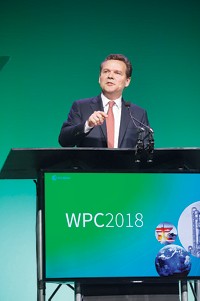Advertisement
Grab your lab coat. Let's get started
Welcome!
Welcome!
Create an account below to get 6 C&EN articles per month, receive newsletters and more - all free.
It seems this is your first time logging in online. Please enter the following information to continue.
As an ACS member you automatically get access to this site. All we need is few more details to create your reading experience.
Not you? Sign in with a different account.
Not you? Sign in with a different account.
ERROR 1
ERROR 1
ERROR 2
ERROR 2
ERROR 2
ERROR 2
ERROR 2
Password and Confirm password must match.
If you have an ACS member number, please enter it here so we can link this account to your membership. (optional)
ERROR 2
ACS values your privacy. By submitting your information, you are gaining access to C&EN and subscribing to our weekly newsletter. We use the information you provide to make your reading experience better, and we will never sell your data to third party members.
Business
Petrochemicals Rise Again
Strong Asian growth has reinvigorated the global petrochemical industry
by Alexander H. Tullo
April 11, 2011
| A version of this story appeared in
Volume 89, Issue 15

In recent years, economic growth in Asia has been the keystone holding the global petrochemical industry in balance. It prevented the industry from collapsing under the weight of the recession and a massive influx of new capacity. And it is helping North American producers, which enjoy a low-cost position thanks to cheap natural gas, mount a comeback.
These were the themes of conferences held in Houston last month by two major petrochemical consulting groups, Chemical Market Associates Inc. (CMAI) and DeWitt & Co. The annual gatherings attract hundreds of petrochemical executives, buyers of chemicals and plastics, financial analysts, bankers, and others who earn a living from petrochemicals.
The tone at the meetings was more positive than it has been since the onset of the recession in 2007. And presenters, including Gary Adams, CMAI’s president, expressed amazement at how resilient the petrochemical industry has proved itself to be given the challenges it has faced in recent years.
“In markets like these, there is practically no conventional wisdom,” Adams told attendees. “Oil prices have risen at an alarming rate. However, chemical sector earnings continue to excel. Capacity additions have reached record proportions in the past few years. Yet demand and operating performance match up. The pull that China and Asia has represented on the rest of the market has remedied weakness in other regions,” he said. “Conventional wisdom would say that we would not have the market conditions we have today.”
Adams pointed out that Asia represented 176% of global demand growth in basic petrochemicals and plastics in 2009. The figure exceeds 100% because demand declined in the rest of the world. From 2010 through 2015, CMAI forecasts, Asia will account for two-thirds of global demand growth.
Because Asian markets seem to be equal to the task of absorbing surpluses, Adams thinks that overcapacity is not likely to be a problem for petrochemical producers in the coming years. “I don’t think that we can get ahead of the amount of capacity that is necessary in that region to satisfy this population that is yearning for more,” he said.
The Asian juggernaut is also helping to support a strong rebound out of the recession for the North American industry, which finds itself in an internationally competitive position thanks to cheap natural gas extracted from shale deposits. U.S. and Canadian producers normally export about 10% of their combined output of polyethylene, polypropylene, and polyvinyl chloride. They are now exporting more than 20% and will export at such high levels for the foreseeable future, Adams noted.
At the DeWitt conference, Mazlan Razak, who follows Asian polyolefin markets for DeWitt, noted that Asian polyethylene demand increased by 17% in 2009 and another 10% in 2010, hitting about 31 million metric tons. Polypropylene demand increased by 16% in 2009 and 7% in 2010, to reach 25 million metric tons. “There is no surplus, and in certain instances we are looking at a snug situation,” he remarked. Razak expects supply and demand to be balanced for the next five years.
Earl Armstrong, DeWitt’s managing director, called the petrochemical industry’s current phase a “phantom down cycle.” Industry profitability hasn’t taken as much of a hit as it should have given the massive amount of capacity that has recently started up in the Middle East. “Somehow, the balances and the product prices just seem too tight and too high for all of the excess capacity that we have been expecting from the Middle East and other places over the last few years,” he observed.
In addition to strong Asian demand, Armstrong noted, Middle Eastern capacity hasn’t been able to ramp up as quickly as expected. For example, polyethylene plant operating rates in the region fell from about 85% in 2009 to 75% last year, and they remain at about that level today. “Some portion of this is a result of just starting up and proving out many new plants,” he said.
The unrest in the Middle East factored into presentations at the conferences. Because the Middle East and North Africa represent only about 5% of global economic output, Tim Hopper, CMAI’s chief economist, doesn’t expect the direct consequences from the unrest to be severe.
However, its impact on oil prices could be important. If oil prices climb to $115 per barrel from their current levels of $100 to $110, global economic growth would slow moderately, he said. Oil prices of $135 could cause a mild recession in Europe. Rates of $150, like those at the onset of the recent recession, could cause a downturn in the U.S. and slow Asian growth.
But the conferences focused more on the abundance of natural gas than it did on the potential scarcity of oil. Investing in the U.S. is back in vogue because horizontal drilling and hydraulic fracturing are tapping into shale and “tight” sands gas deposits, providing a cheap source of additional ethane feedstock for ethylene crackers.
The keynote address at the CMAI conference was given by Alan S. Armstrong, chief executive officer of gas processor Williams Cos. “Four years ago, many of the [major energy companies] couldn’t believe that these tight gas supplies could be produced economically,” he said.
Armstrong believes that the amount of natural gas extracted from shale can only rise because the technology will improve and abundant resources—such as the Marcellus Shale in Pennsylvania and West Virginia—have yet to be fully tapped. “Every time a well is drilled, we learn to fracture it a little better,” he said.
After 10 years without a new ethylene cracker, the U.S. is starting to be perceived as a place to invest. At its conference, CMAI projected that two new crackers—one on the Gulf Coast and another elsewhere in the U.S., together representing about 1.6 million metric tons of annual capacity—will start up in the U.S. by 2017. CMAI expects incremental capacity additions at existing plants will add 1.2 million metric tons to the market by 2015.
This prediction started to become a reality only a few days after the conferences wrapped up when Chevron Phillips Chemical announced that it is studying a new ethylene cracker at one of its Gulf Coast sites. The capacity would be more than 1 million metric tons, comprising the lion’s share of new cracker capacity in the CMAI forecast.
For now, the petrochemical world is in balance and prosperous, and it is expected to remain that way for several more years. But industry executives aren’t letting down their guard. As they are all too aware, this new conventional wisdom can also be defied.





Join the conversation
Contact the reporter
Submit a Letter to the Editor for publication
Engage with us on Twitter